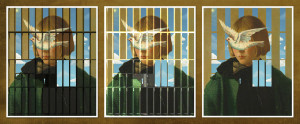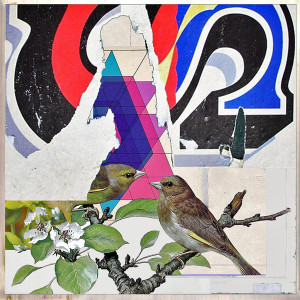I
How do you photograph silence? Is it represented by an empty room? A sleeping baby? A seascape? Such photos may lend a sense of quiet to the onlooker, but in reality, such scenes are not silent. An air conditioner is humming in the empty room; a sleeping baby is snorting and gurgling as she is turning over; the wind is stirring up the waves on the ocean and crashing them onto the shore.
II
III
I have never been in a vacuum (like space) in which sound cannot exist, but I have been all alone where (as far as this non-scientist could tell) there were no sounds. And yet, I must admit that it was not truly silent. My ears sensed sound, similar to when you put a seashell up to your ear to “hear” the ocean, but in fact – or so I was told as a child – you are only hearing the sound of your own blood circulating in your body. Today scientists believe the most likely source of that sound is an echo from the noise in the air around you. The seashell captures that ambient noise, which then resonates inside the shell. That is one example of the eternal hum of non-silence that we cannot escape and thus, is part of our existence.1
Yes, scientific studies have proved that silence does have a sound. Robert Boyle determined this by setting a ringing alarm clock inside a glass jar. Gradually, as the air was sucked out of the jar, the ringing also died out, because there was nothing – whether gas, solid, or liquid – for the sound to pass through. Sound is an experience interpreted by the brain. The brain demands stimuli, and if we deprive it of such, it will create its own: that “eternal hum.” 2
IV
A friend of mine recalled a time, towards the end of World War II in Europe, when he and his family found themselves in an unexpected situation: “We didn’t plan on it, but we spent the night in the Dresden train station. For hours all we did was stand and wait. The station was overcrowded with refugees fleeing the bombing raids. Everything had ground to a halt. The noise was incredible – parents calling out to children and children calling to pets who had escaped. Sobs and screaming were reactions to the dearth of information and the lack of food as well as to sudden and unexpected death. At the same time, the silence was oppressive: no engine sounds; the conductors weren’t calling for passengers, and the loudspeaker had long since stopped informing us of the immediate departure of the trains.” That moment, as well as their future, was defined by silence.
V
“I often regret that I have spoken; never that I have been silent.” – Publilius Syrus
When we think of ourselves, we usually imagine ourselves to be center stage, the star of the show with all eyes upon us. In that role, we love to speak, to expound, to be dramatic and appear savvy. But were we to see things as they are, we would realize that we are really somewhere off-stage, in the wings, always awaiting our cue. And so, we most often simply look and sound, at best, pretentious and at worst, somewhat silly. This oft-quoted aphorism, often attributed to Mark Twain or Abraham Lincoln, indicates a different way to appear intelligent: “Better to remain silent and be thought a fool than to speak and remove all doubt.” And a Danish proverb tells us: Speaking silence is better than senseless speech.
Philosophers have expressed the same thought. Francis Bacon declared that “silence is the virtue of fools.” The Polish poet C. K. Norwid said that rather than talking to another person, it is sometimes “better to talk to silence.” 3
But how would I speak to silence? Must I be silent myself? And if I did, can silence respond?
The same friend who was stranded in the Dresden train station, had just fled a city that had been part of Germany but was then, in May of 1945, becoming Poland. To complete the overthrow of the German occupiers, the Polish government forbade the use of the German language, whether spoken or written. Polish officials would listen at windows to see if they could hear German being spoken; books, birth certificates, and other documents written in German were destroyed. If the German language was forbidden, what of thoughts conceived in that language? Did my friend have any thoughts at all anymore? Or were they of necessity still-born? Silence imposed can be the cruelest sentence of all.
VI
“How does one photograph silence?” That question intrigues me as I think about how silence permeated our lives in the first days of the pandemic. How would you have photographed that silence? Would you have taken a photo of empty streets? Of empty shopping malls? Deserted offices? Would you have taken a photo of the now-empty chair where your friend always sat when she came to visit? – but then, she doesn’t visit anymore.
During the last couple of years, I think most of us, in the time since what we accepted as normal began to gradually disappear, have experienced unexpected silences: where there was once the noise of traffic and family gatherings; the background buzz of voices; the murmur of one-on-one heartfelt talks, silence now reigns. This silence was unsettling and raised unanswerable questions. How do you get through a crisis when you realize that, at the end of the day, everything might not be all right?
When the pandemic began, I went through a couple of weeks of irrational panic. I couldn’t remember what day it was. One week, every day, I asked my husband what time he wanted lunch “today” – Saturday. He would gently tell me, “Constance, today is Wednesday … or Thursday… or Friday…” until he could finally give me an answer: “2 o’clock.”
I like to think I am someone who can roll with the unexpected; nonetheless, I always plan out the next week or month in some detail, even knowing some things might have to change. But suddenly, there was no way to plan much beyond lunchtime. I started to feel very, very alone. Lunches out with friends ceased. I was discouraged from going to the grocery store. I couldn’t drive to visit my children in Washington or Texas. The zoo was closed; museums were closed; the malls were closed. I finally had all the time I had ever wanted to read – and then, I didn’t want to read any more.
VII
VIII
IX
Debussy famously wrote that the music is not in the notes, but in the spaces between them. Miles Davis echoed that, saying “It’s not the notes you play; it’s the notes you don’t play.”
Playing bassoon in an orchestra as I did for many years, gave me the perfect chance to realize that. In Mendelssohn’s Violin Concerto in E Minor, the composer didn’t stop the music between movements as is usual, because he hated audiences who clapped during what should have been a silent pause. So, to bridge the first and second movements, the principal bassoon plays a sustained B which eliminates any silence (and also any clapping) and gives the solo violin its cue to begin the Andante. At the first rehearsal, used as I was to simply playing the bass note to the other woodwinds, I missed my cue because no one else was playing. Stop the whole orchestra. Point the baton and glare at me. Begin again. At the cue, I played. It was an otherworldly feeling to be in a concert hall surrounded by eighty other musicians silently listening to me sound one prolonged note. The silence was more pronounced than the sound of the lone bassoon.
X
the mundane language of household chores
the language of caring
the nonsense language of babies goo-goo, ga-ga
the language of hurt
But he found language too banal to express the horrors of the Holocaust he was trying to evoke. He resorted to silence, but also to a rush of words spoken without pause, without breath. His most famous poem, “Todesfuge” uses both methods. The long second-to-last stanza, should be read without taking a breath, as if the horrors will out, but only en masse. Singly, the thoughts would fail. It begins:
There is no punctuation. Thoughts cannot be paused – the horror is too great. Thoughts cannot be comprehended. The horror is too great. Read it. Read it again quickly without taking a breath. Read it so quickly you are out of breath when you finish. Then, silence, except for the harshness of your staggered breaths.
XI
Now, how do you write silence?
XII
Silence is the most forgotten part of speech in every grammar of every language. Communication is not simply composing speech or writing a message. Even as we recite something or respond to a friend, we are not voicing an unbroken stream of sound. Our pronunciation alone includes silences we term the “glottal stop.” The glottal stop is where breath is withheld for a brief moment before the sound of speech resumes. It is best heard in the phrase “uh-oh,” and is that nearly imperceptible click (where the speaker interrupts the air flow) between the two syllables. We don’t even notice we stop the sound when we pronounce words like “button”: in speech the “t” sound disappears altogether and the word sounds like “bu-un,” with that click of a glottal stop between the two “u” sounds.
Is that even important? Yes, it is. Silence is not, as we often conceive it, merely a monolith of the extended lack of sound. It is a part of even the smallest syllables of our speech – which we normally think of as an unbroken wall of sound. The silence is what makes the sounds comprehensible.
Silence is terrifyingly present in what is never given voice. Martin Luther King said, “In the end, we will remember not the words of our enemies, but the silence of our friends.”
We are so anxious, not to understand each other, but to be understood, that we listen more to the silences in speech than to what is actually articulated. We try so hard to interpret breaks in the flow of communication. We can recognize the pregnant pause, the stunned silence, the expectant hush. A one-beat delay in answering a question can be interpreted as non-agreement, disdain. It can make us feel foolish.
In the final minutes of “Miss Pettigrew Lives for a Day,” Joe and Guinevere have a dialogue where the most important point is articulated through a silent nod:
[Joe] I’m looking for you.
[Guinevere] Me?
[Joe] I’ve been looking for you all night, and, I believe all of my life.
If you’ll have me.
[No response, and Joe cannot read the silence.]
[Joe] A nod of the head will do me fine.
[Guinevere: Wordless, silent nod.]
[Joe] And I am, at a stroke, the happiest man in London.7
XIII
I only imagine I understand silence. What is silence in any case? The absence of speech? The absence of thought? And what are the consequences of too much uninvited silence?
Aunt Jean: Beautiful, Aunt Jean. You were too young when you married; too young to have borne four daughters; too innocent to have known how to live with a husband whose being was shattered from an upbringing that was both silent (he was alone so often; the forgotten child) and harshly abusive (that succession of stepfathers). He knew no other way, so he was alternately silent and then harshly abusive to you. You could not understand abuse, so you chose your own silence: turning on the motor with the exhaust gradually filling the car where you sat, silently waiting.
Great-Uncle Rufus: I only met you a few times. I was too young to understand why you were unshaven, wore dirty clothes, talked too loudly. You were quite a contrast to my grandmother’s home in Ft. Lauderdale, Florida. The city of canals, of a brilliant blue sky, with the stark white of sails capturing the wind to power the yachts. Her home was equally white and ostentatious in an upper-middle class way. In contrast, the St. Augustine grass gave the lawn a brilliant green hue, hiding from the uninitiated the danger of trying to walk barefoot on it. Your appearance unsettled me and I would be silent myself, peering around doors to see you and wondering why my grandmother, your little sister, screamed at you instead of using “an indoor voice.” I didn’t understand deafness. Oh, I knew it meant that, in your case, you couldn’t hear much. But what did it mean to you? Did you sense what you were not-hearing; were you able to interpret the silence that gradually overtook you? As your deafness worsened, were you overwhelmed by how very loud the silence was, drowning out the sounds you wanted to hear? Were you eventually isolated until you felt utterly alone? Years later, I saw your death certificate. Someone had forgotten to redact the cause of death, because there it was: “suicide: gunshot to the head.” You dear, man! Would it have made a difference all those years ago if I had been less scared; if I had given you a hug; if you could have known you had value? Nothing is more isolating than trying to exist within the silence of not being seen. So, you shattered that silence with your own hand, sending yourself – I hope –
to a better place where gentle, kind sounds caress your ears.
XIV
Corinna da Fonseca-Wollheim is fascinated with a 2,000-year-old bell from Japan, a dotaku, that is on display at the Metropolitan Museum of Art. The bell was built to be mute, made without a clapper and then buried for the purposes of a lost ritual.
She writes: “The first time I saw the Met’s dotaku, I stopped dead in my tracks. The expectation of sound had been turned into a sacrificial act of silence.”
XV
How do you photograph silence?
How do you hear silence?
How do you speak silence?
How do you see silence?
How do you sense silence?
How do you write silence?
How do you play silence?
How do you ignore silence?
How will you photograph silence?
S
l
L
E
N
C
E
Footnotes
- One woman named Sylvia, in Nina Raine’s Tribes, reports on the experience of going deaf, “No one told me it was
going to be this noisy ... It’s this buzz. This roar and outside ... it’s all—black.” - https://owlcation.com/stem/Does-Silence-Make-a-Sound. Journey Holm, Apr 5, 2020.
- Dr. Tadeusz Kobierzycki, “On the Philosophy of Human Silence (Thinking within the Limits of Words and Things)”
Paper to: XXIII World Congress of Philosophy, Athens 04-10 August 2013. University of Athens, School of
Philosophy. https://dezintegracja.pl/the-philosophy-of-human-silence-thinking-within-the-limits-of-words-and-
things/ Researchers now think that this aphorism was actually first articulated by Maurice Switzer in 1907. NPR,
“All Things Considered,” Author Interviews, “Hemingway Didn’t Say That (and Neither Did Twain or Kafka),” 4 April
2017, KUER, channel 7, Utah https://www.npr.org/2017/04/04/522581148/hemingway-didnt-say-that-and-
neither-did-twain-or-kafka - Will and Ariel Durant: The Lessons of History, 13. New York: Simon and Schuster, 1968.
- Kristina Marie Darling, “Silence in Poetry,” Ploughshares Blog, 4 October 2018, https://blog.pshares.org
- Paul Celan, “Todesfuge,” Paul Celan Gesammelte Werke in fünf Bänden, Erster Band, Gedichte I, Frankfurt am Main: Suhrkamp Verlag, 42. My translation. For effect, I have altered the line spacing.
- Everything in square brackets has been added by me. I have also altered the line spacing. http://www.script-o-
rama.com/movie_scripts/a2/mrs-pettigrew-lives-for-a-day-script.html







